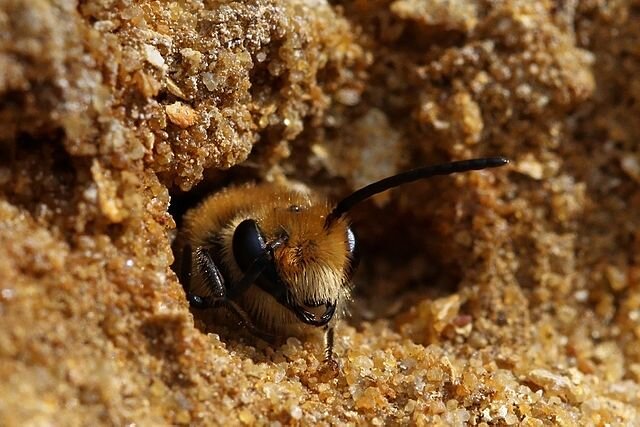Do Bees Live Underground?

Kim Fellows
Places for Our Ground-Nesting Bees
When you think of a nesting place for bees, you may be picturing an old-fashioned “skep” — a domed structure made of twisted straw or wicker — or a typical boxed man-made hive, both of which are places where honey bees live. Skeps have been outlawed in North America, since the bees construct the honey combs such that they are directly attached to the skep and cannot be inspected. A typical box hive, on the other hand, has mobile frames that the bees use to store honey and raise their brood. There are several other kinds of hives that have been used in the history of beekeeping.
Regular readers of this bulletin are aware that Canada hosts over 850 species of bees, in addition to the honey bee. We’re talking about bumble, mason, carpenter, sweat, mining and squash bees, to name a few. Bumble bees are also social, living in a colony and raising their young together, like honey bees, and there even exists a managed industry for bumble bees, who are expert pollinators of tomato and pepper plants in greenhouses. Such greenhouse pollinators are provided with modified banker boxes in which to live. The alfalfa leafcutting bee has artificial domiciles made for it, to facilitate pollination in alfalfa fields. However, 70% of native bees across Canada nest in the ground. The other 30% are called cavity-dwellers, or above ground nesters.
Homes suitable for bees include hollow or pithy plant stems (such as boxelder, elderberry, blackberries or raspberries (Rubus species), sumac, dogwood, cup plant), tree stumps and other deadfall. It’s best to leave such stems and deadfall in place if you wish to encourage pollinators to thrive on your property. Non-managed bumble bees are opportunists who will occupy abandoned rodent burrows, rock wall jumble, grassy tussocks, junked cars and spaces in sheds.
Considering that 70% of our native bees are ground-nesters, I thought I’d provide some tips for making this kind of habitat available, in addition to the wonderful food you plant for pollinators.
First of all, consider that thickly mulched ground and landscape fabric make it difficult, if not impossible, for bees to nest in the ground. Well-draining soils that are sandy or loamy are preferred. A gentle slope to the south is ideal, as the sun’s warmth helps activate the bees, plus south-facing slopes tend to be drier. Bees will avoid areas that are typically wet, as the moisture compacts the soil and doesn't allow for easy tunnel building.
This resource suggests creating a stable pile of soil, about two feet high. “Different species of bees nest in different soil types, but the soil should be at least 35 percent sand. If necessary, contain the pile with walls of lumber or bricks. Experiment by creating piles with different soil mixtures or by placing piles in locations that receive different amounts of sun“.
--
Photo: Colletes bee guarding ground nest. Photo by Charles J Sharpe CC BY-SA 4.0.
Not yet a member?
An annual membership to Seeds of Diversity gives you access to our seed exchange, seed grow-out programs, and our online news.

We depend on donations to do our work.

Thank you for your support!
